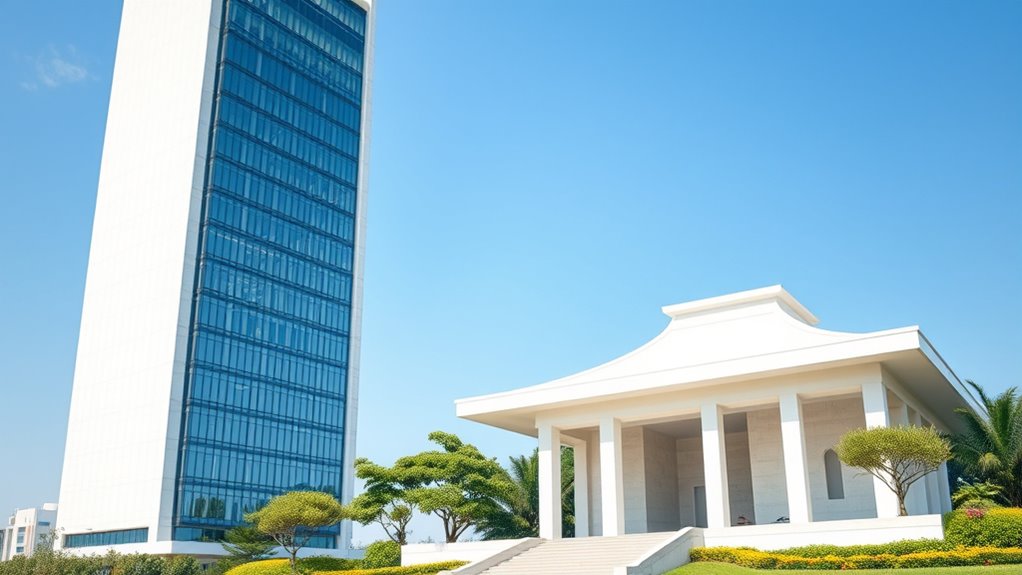In 2025, minimalist architecture worldwide transforms urban landscapes with sleek designs, eco-friendly materials, and smart technologies. You’ll see skyscrapers with clean lines, sustainable villas with adaptive materials, and public spaces that promote simplicity and natural elements. Regional influences blend traditional craftsmanship with modern minimalism, shaping culturally resonant homes. As cities embrace green infrastructure and innovative designs, you’ll discover how less truly becomes more—exploring the exciting future of minimalist architecture across the globe.
Key Takeaways
- Global minimalist architecture in 2025 emphasizes sustainable materials, adaptive smart surfaces, and energy-efficient design principles.
- Urban skylines feature sleek, streamlined skyscrapers integrated with green infrastructure like vertical gardens and solar glass.
- Regional influences blend traditional materials with modern minimalism, creating culturally resonant, functional spaces worldwide.
- Public spaces prioritize simplicity, fostering community interaction, environmental harmony, and calm aesthetics through minimalist layouts.
- Technological advances enable rapid, precise designs using algorithmic tools, ensuring safety, regulation compliance, and sustainable innovation.
The Rise of Urban Minimalism: Skyscrapers Redefining City Skylines
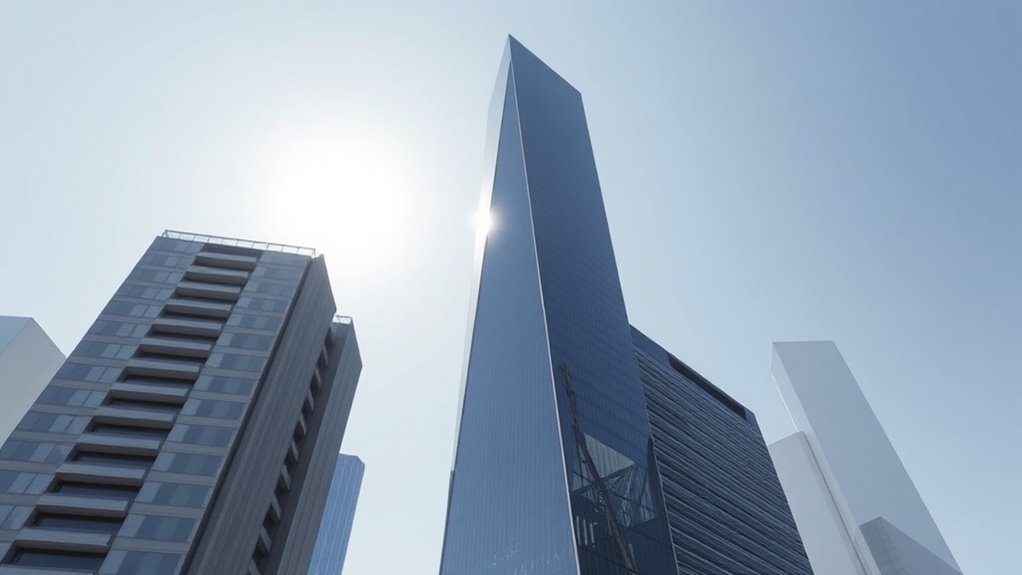
As cities grow denser, urban minimalism is transforming skylines with sleek, streamlined skyscrapers that prioritize simplicity and functionality. You’ll notice how these buildings embrace clean lines and uncluttered facades, reducing visual noise.
With increasing urban density, architects focus on maximizing space efficiency without sacrificing aesthetic appeal. Minimalist landscaping around these structures emphasizes natural elements like greenery and stone, blending architecture with nature effortlessly. Incorporating efficient space utilization and thoughtful design principles ensures these skyscrapers contribute to a harmonious and sustainable city environment. Additionally, the use of sustainable building materials further enhances eco-friendly urban development.
This approach not only creates a calming skyline but also promotes sustainable urban living by reducing energy consumption and maintenance. You’ll see how the emphasis on minimalism fosters a cohesive cityscape that feels open and uncluttered, making urban environments more inviting and easier to navigate. Implementing renewable energy solutions, such as solar panels integrated into building design, further supports the goal of eco-conscious development. Moreover, focusing on interior design principles helps ensure these structures maintain a balance between exterior simplicity and functional, comfortable indoor spaces.
Sustainable Serenity: Eco-Friendly Retreats and Villas
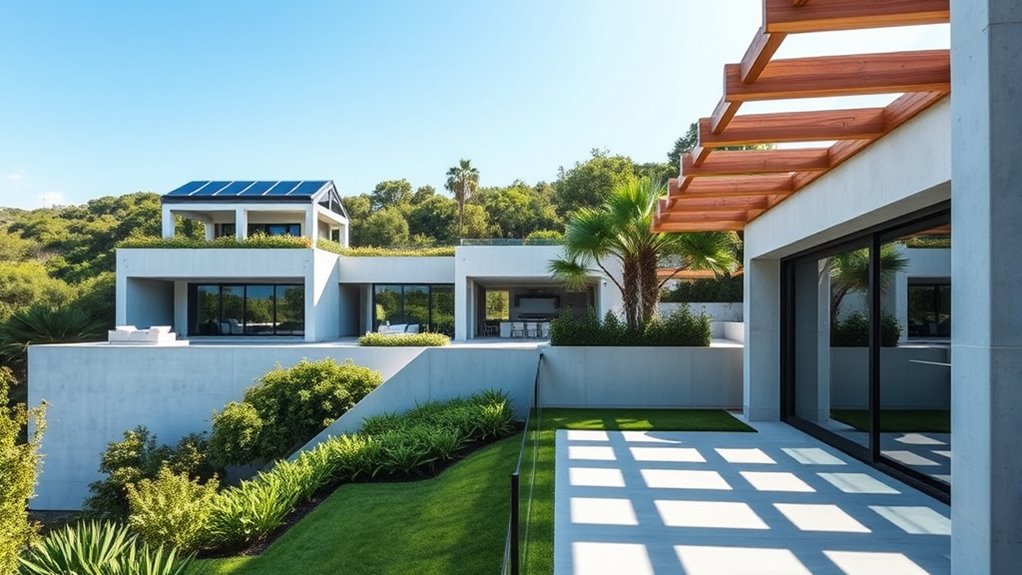
Building on the minimalist aesthetic sweeping through urban skylines, eco-friendly retreats and villas embrace sustainability without sacrificing elegance. You’ll find solar-powered retreats that harness sunlight for energy, blending seamlessly into natural surroundings. These retreats prioritize eco-conscious living, using renewable resources to minimize environmental impact. Water conservation features integrated into design further reduce ecological footprints, ensuring responsible resource use. Incorporating environmental metrics helps monitor and improve sustainability efforts throughout the development process. The use of multi-functional furniture in these spaces enhances versatility and reduces clutter, aligning with minimalist principles. Additionally, implementing fraud detection techniques can help protect these eco-friendly developments from financial fraud and chargebacks, ensuring sustainable growth. Zero waste villas stand out by reducing waste through innovative design, composting, and recycling systems, ensuring minimal ecological footprint. The focus remains on simplicity and functionality, with natural materials and clean lines enhancing serenity. You feel connected to nature while enjoying modern comforts, knowing your stay supports a sustainable future. These retreats embody minimalist principles—clutter-free, efficient, and environmentally responsible—creating spaces where tranquility and sustainability coexist effortlessly. Incorporating sound design techniques can enhance the calming atmosphere of these retreats, making them even more inviting and immersive.
Technological Innovations in Minimalist Design
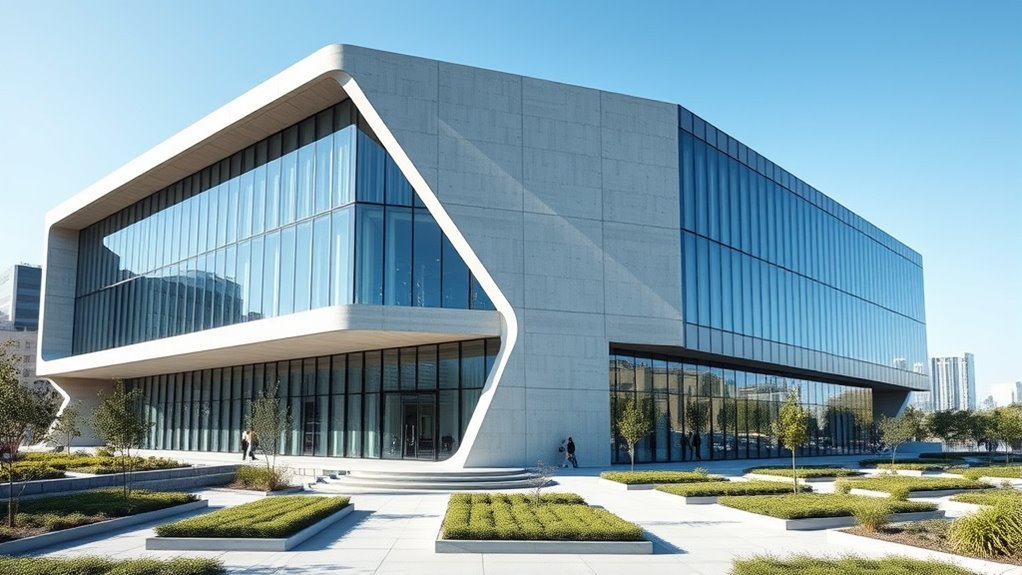
You’ll see how smart materials seamlessly adapt to your living space, enhancing both form and function. Privacy policies ensure that user data is protected while enabling personalized experiences. Automated design processes now enable faster, more precise customizations that reflect your unique style. These technological innovations are revolutionizing minimalist architecture, making it smarter and more responsive than ever. Additionally, sustainable building practices incorporate eco-friendly materials and energy-efficient systems, aligning modern design with environmental responsibility. Incorporating adaptive materials can also improve the durability and efficiency of architectural components, demonstrating how innovative materials can enhance both form and function in minimalist design. Innovations in creative practice are also inspiring architects to explore new forms and solutions, fostering a culture of continuous experimentation. Integrating advanced tuning technologies from the automotive industry demonstrates how innovative materials can also promote durability and efficiency in architectural components.
Smart Materials Integration
Smart materials are revolutionizing minimalist architecture by enabling buildings to adapt seamlessly to their environment. By leveraging biomimicry principles, these materials mimic natural processes, enhancing sustainability and efficiency. Nanotechnology applications allow for precise control over material properties, making surfaces self-healing or energy-responsive. You’ll notice that integrating these innovations creates structures that are both sleek and functional, reducing the need for external systems. The table below highlights key smart materials:
| Material Type | Key Features |
|---|---|
| Thermochromic | Changes color with temperature shifts |
| Self-healing concrete | Repairs cracks autonomously |
| Photoresponsive glass | Adjusts transparency with light exposure |
| Shape-memory alloys | Alter shape based on heat or stress |
| Nanostructured coatings | Enhance durability and resistance |
These advancements exemplify how minimalism merges with technology, shaping the future of architecture. Additionally, understanding payment processing concepts can help in managing the financial aspects of implementing these advanced materials in large-scale projects. Moreover, integrating ethical hacking techniques into the security planning of smart buildings can prevent vulnerabilities related to digital control systems. Incorporating sustainable practices in design further ensures that these innovations contribute positively to environmental conservation. As the adoption of smart materials grows, regulatory standards are also evolving to ensure safety and effectiveness in construction.
Automated Design Processes
Advancements in automated design processes are transforming how architects approach minimalist architecture by streamlining workflows and enhancing precision. Automated design tools enable you to rapidly generate multiple minimalist concepts, saving time and reducing human error.
Algorithmic architecture allows for complex forms and structures to be optimized through algorithms, creating innovative yet simple designs. With these technologies, you can easily experiment with form, material, and spatial arrangements, ensuring your minimalist vision is both functional and aesthetically refined.
Automation also facilitates seamless integration of sustainability features, making your designs more eco-friendly. By leveraging automated design, you gain a competitive edge, producing cleaner, more efficient structures that embody the essence of minimalism while embracing technological innovation.
Cultural Influences Shaping Modern Minimalist Homes
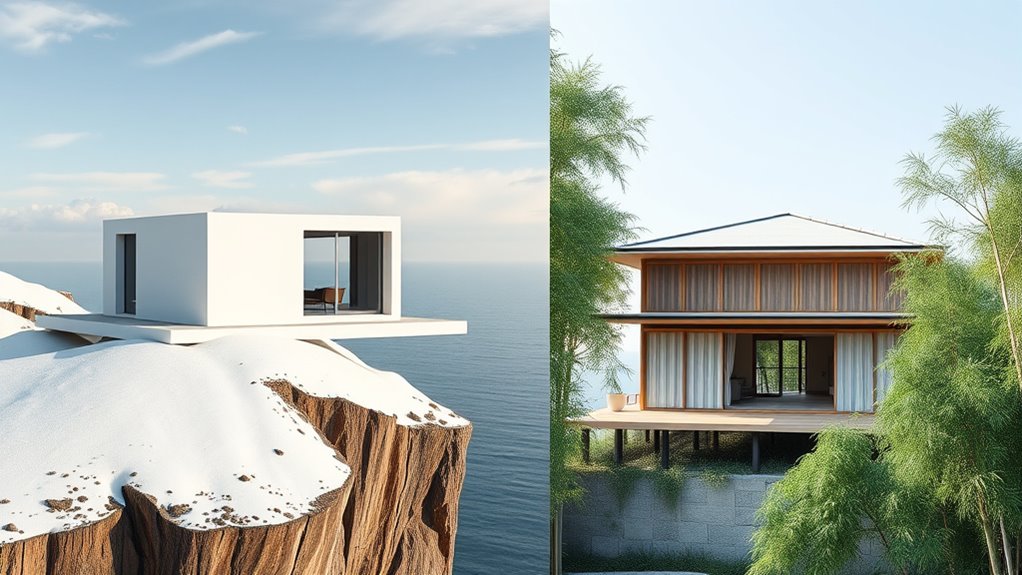
You’ll notice how traditional materials are blended with modern designs, creating homes that honor history while remaining minimalist. Regional color palettes influence your surroundings, giving each space a unique cultural identity. Indigenous design elements add authenticity and richness, making minimalist homes feel deeply connected to their roots. Incorporating cultural intelligence practices can enhance the overall harmony and balance within these spaces, fostering a more mindful living environment.
Traditional Materials Fusion
As minimalist architecture continues to evolve globally, designers are increasingly blending traditional materials with modern aesthetics to create spaces that honor cultural heritage while embracing simplicity. You’ll notice a focus on traditional craftsmanship and historic material preservation, which add depth and authenticity to minimalist designs.
This fusion involves:
- Using locally sourced materials like timber, stone, or clay to maintain cultural significance.
- Incorporating handcrafted elements that highlight traditional techniques within sleek, modern forms.
- Preserving historic structures or materials to blend old-world charm with minimalist clarity.
This approach not only respects cultural roots but also adds tactile richness and visual interest to minimalist homes, making them more meaningful and rooted in tradition while maintaining clean, simple lines.
Regional Color Palettes
Regional color palettes play an essential role in shaping modern minimalist homes by reflecting local cultures and environments. They create a sense of authenticity and deepen the connection between the space and its surroundings.
When choosing colors, you’ll notice a focus on color harmony that complements regional aesthetics—whether earthy tones inspired by desert landscapes or cool shades echoing coastal environments. These palettes often incorporate natural hues that evoke the climate and terrain, fostering calming and balanced interiors.
Indigenous Design Elements
Indigenous design elements bring a rich tapestry of cultural traditions into modern minimalist homes, infusing spaces with authenticity and a sense of heritage. By integrating native craftsmanship, you honor centuries-old techniques while maintaining sleek simplicity.
These elements add subtle textures and meaningful symbolism, enriching minimalist aesthetics without clutter. You might incorporate:
- Hand-carved wooden accents reflecting local artistry
- Traditional woven textiles used as wall hangings or upholstery
- Natural materials like clay, stone, or bamboo sourced sustainably
These choices preserve indigenous identities and create a connection between past and present. Embracing indigenous design allows you to craft spaces that are both minimalist and culturally rooted, celebrating diversity while maintaining a clean, modern look.
Public Spaces and Minimalist Architecture in Urban Planning
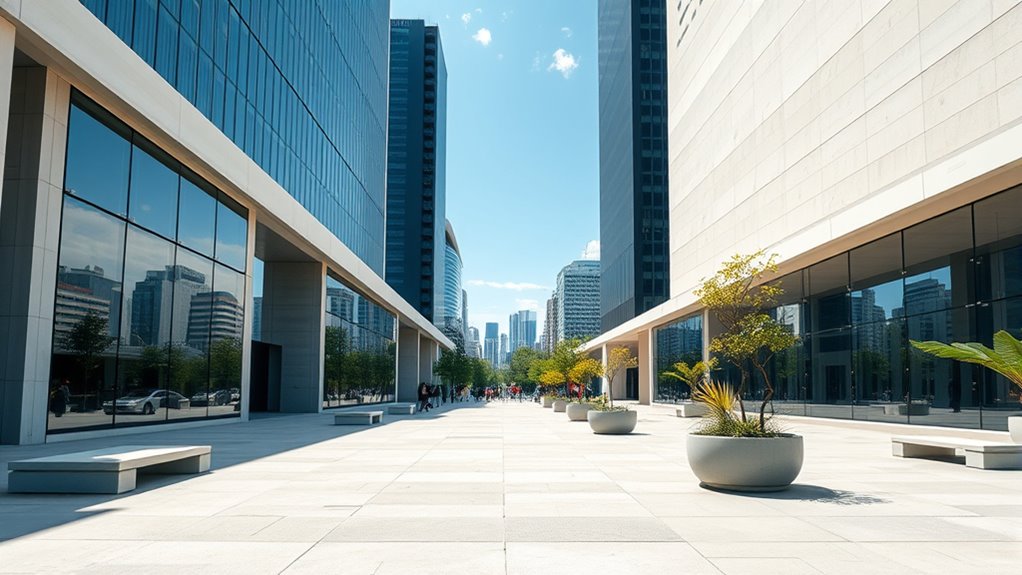
Minimalist architecture has become a defining feature of modern urban planning, shaping public spaces that prioritize simplicity and functionality. You’ll notice urban gardens designed with clean lines and minimal ornamentation, creating peaceful retreats amid bustling cities.
Minimalist architecture defines modern urban spaces with simple, functional designs and tranquil gardens.
Public seating integrates seamlessly into these spaces, often built with natural materials and simple forms that invite relaxation without distraction. The focus is on maximizing usability while maintaining aesthetic clarity.
These minimalist elements encourage social interaction and community engagement, making public areas more inviting. By stripping away excess, urban planners create open, versatile environments that serve diverse needs.
The result is public spaces that feel spacious, calming, and accessible, reflecting a global shift toward sustainable, efficient, and beautifully understated urban design.
Minimalist Art and Architecture Fusion
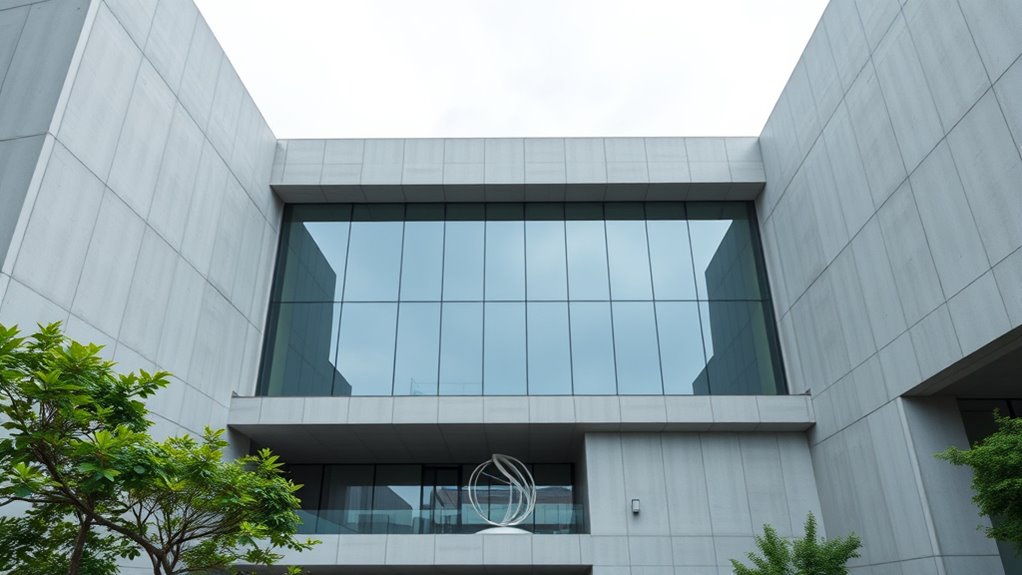
As minimalist architecture continues to emphasize clean lines and functional design in urban spaces, it increasingly intersects with minimalist art to create compelling visual experiences. This architecture fusion enhances spaces by blending simple forms with subtle artistic elements, fostering a sense of visual harmony.
To deepen this connection, consider these key aspects:
- Integrating sculptural elements that complement building forms, emphasizing simplicity and balance.
- Using monochromatic palettes to unify structural and artistic components seamlessly.
- Incorporating installations that serve both aesthetic and functional purposes, reinforcing the minimalist ethos.
This synergy between minimalist art and architecture invites viewers to appreciate understated beauty while maintaining clarity and purpose. The result is environments that feel both serene and thought-provoking, embodying true visual harmony.
Adaptive Reuse and Minimalist Renovations
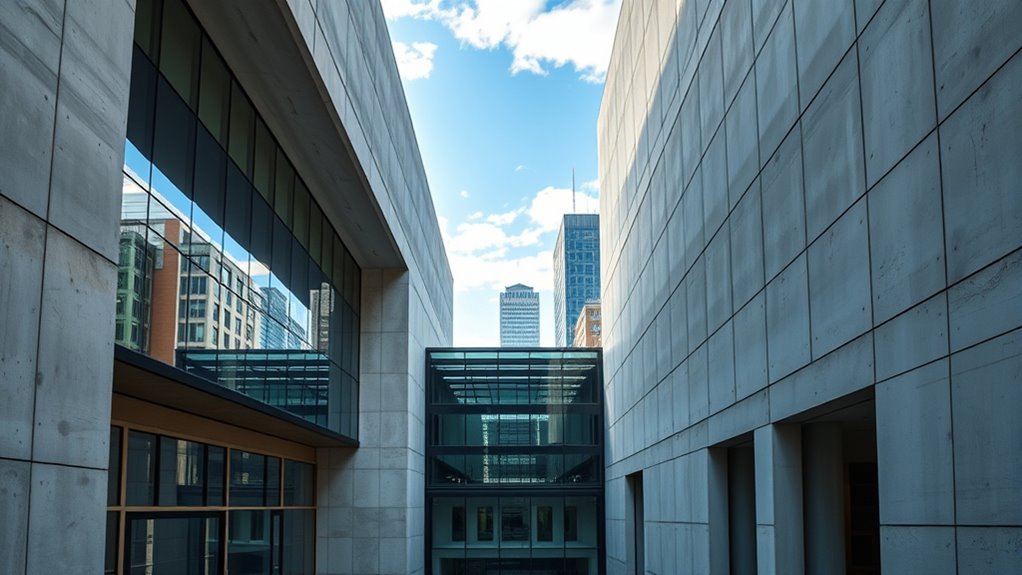
When transforming existing buildings, architects often turn to adaptive reuse combined with minimalist renovations to create sleek, functional spaces that respect their historical essence. This approach emphasizes historic preservation by maintaining key architectural features while streamlining interior layouts.
You’ll find that adaptive reuse allows you to breathe new life into old structures without sacrificing their character. Minimalist renovations enhance this process by stripping away unnecessary ornamentation, focusing on clean lines and open spaces.
This combination reduces waste and operational costs, making projects more sustainable. As a result, you get spaces that honor the past while embracing modern simplicity.
Your designs become more than just functional—they become a seamless blend of history and contemporary minimalism, reflecting a thoughtful approach to urban renewal and sustainable development.
Material Innovation and Sustainability in 2025
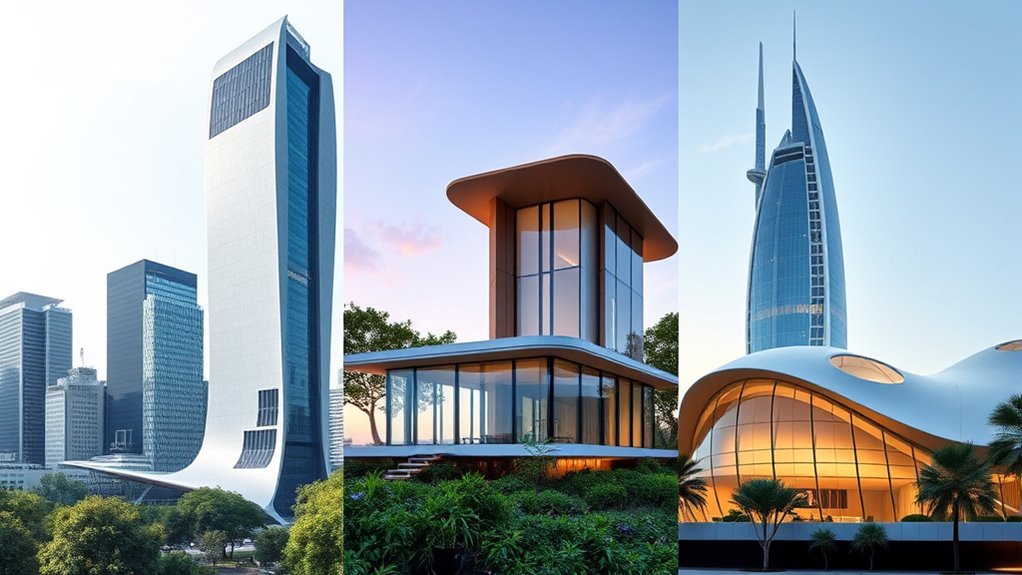
In 2025, material innovation and sustainability are transforming architecture by prioritizing eco-friendly, high-performance building materials. You’ll see the rise of biodegradable composites that reduce waste and improve insulation, offering a sustainable alternative to traditional materials.
Solar glass innovations are now integrated seamlessly into facades, capturing solar energy while maintaining transparency and aesthetic minimalism. These advancements allow structures to generate power and lower carbon footprints effortlessly.
Consider these key developments:
- Biodegradable composites that enhance durability and eco-friendliness
- Solar glass innovations that combine sustainability with sleek design
- Advanced insulation materials that improve energy efficiency while reducing environmental impact
Together, these innovations support minimalist designs that are both functional and environmentally responsible.
Future Trends: Minimalism’s Role in Smart and Green Cities
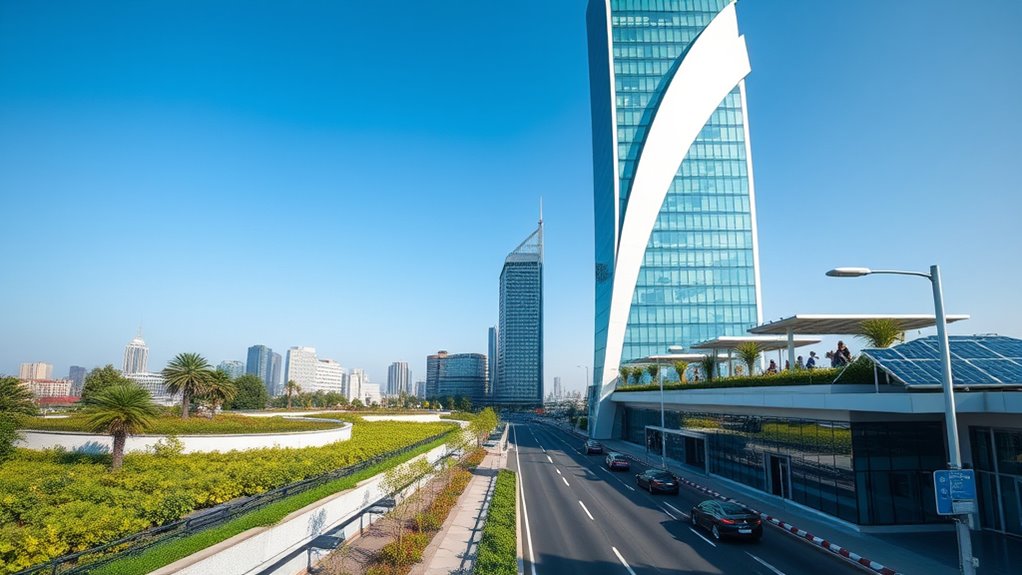
How will minimalism shape the future of smart and green cities? You’ll see a focus on clean lines and functional design that integrates urban greenery seamlessly into cityscapes. Minimalist architecture emphasizes open spaces, reducing clutter while maximizing natural light and ventilation.
This approach supports sustainability goals through energy efficiency and eco-friendly materials. As cities become smarter, you’ll notice a rise in minimalist fashion-inspired designs that promote simplicity and comfort, blending aesthetics with practicality.
Urban greenery, like rooftop gardens and vertical forests, plays a vital role in this minimalism trend, improving air quality and creating calming environments. Together, these elements foster healthier, more sustainable urban living, where less truly becomes more in shaping future cities.
Frequently Asked Questions
How Does Minimalism Influence Affordable Housing Solutions Worldwide?
You see how minimalism shapes affordable housing solutions by emphasizing simplicity and functionality. It encourages the use of sustainable materials, reducing costs and environmental impact.
Cultural influences inspire designs that resonate locally, making homes more meaningful and adaptable. This approach helps you create efficient, cost-effective spaces that meet diverse needs while promoting sustainability.
Ensuring that affordable housing is accessible and environmentally responsible worldwide.
What Challenges Do Architects Face When Designing Minimalist Urban Infrastructure?
Imagine building a delicate bridge of glass and steel, where every beam must balance strength and grace. Architects face challenges like ensuring sustainable materials blend seamlessly with design simplicity.
While urban infrastructure demands resilience and efficiency. You must navigate limited space, budget constraints, and environmental impact, all while maintaining clean, minimalist aesthetics.
The task is complex but rewarding, transforming cities into functional, elegant spaces that stand the test of time.
How Are Local Climates Integrated Into Minimalist Architectural Designs?
When designing minimalist architecture, you focus on integrating local climates through climate-responsive design, ensuring structures adapt to environmental conditions.
You select regional materials that enhance sustainability and blend seamlessly with the surroundings.
By considering factors like insulation, ventilation, and natural lighting, you create simple yet effective solutions.
This approach not only respects the environment but also maintains the clean aesthetic characteristic of minimalist design, making buildings functional and harmonious with their climate.
What Role Do Community Spaces Play in Minimalist Urban Environments?
Think of community spaces as the heartbeat of a minimalist city, much like the agora in ancient Greece. They foster public space and encourage social interaction, essential for urban life.
In minimalist environments, these spaces are intentionally simple yet inviting, serving as hubs where residents connect and share experiences.
Your role is to appreciate how these thoughtfully designed areas enhance community cohesion, making the city feel more vibrant and inclusive.
How Will Minimalist Architecture Impact Future Transportation Infrastructure?
You’ll see minimalist architecture shaping future transportation infrastructure by integrating smart materials that improve durability and adaptability. These designs focus on energy efficiency, reducing environmental impact and operational costs.
As you move through cities, transportation hubs will feature sleek, simple lines with sustainable features, making travel smoother and greener. This approach creates efficient, innovative spaces that prioritize functionality while seamlessly blending into urban environments.
Conclusion
By 2025, over 60% of new urban developments will incorporate minimalist designs, showcasing a global shift toward simplicity and sustainability. You’ll see skyscrapers that blend cutting-edge tech with eco-friendly materials, creating serene cityscapes that prioritize both function and beauty. As minimalist architecture continues to grow worldwide, it’s reshaping how you experience urban life—more sustainable, innovative, and inspiring than ever before. Stay tuned; the future of minimalism is just getting started.
